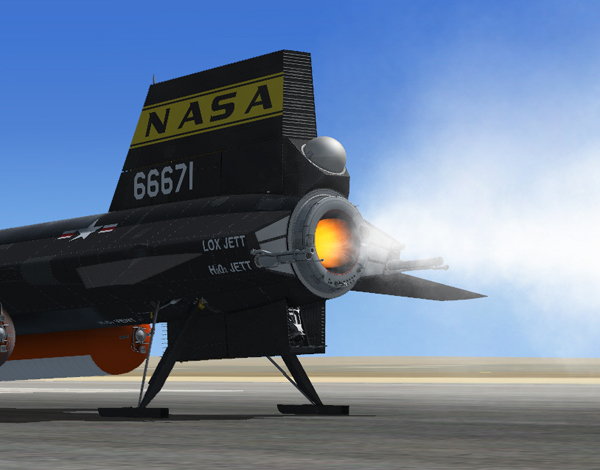The two propellants, anhydrous ammonia and liquid oxygen, are routed from their respective fuel tanks to the main feed valves, which are operated by helium pressure.
From the main feed valves, the fuel is routed to the turbopump.
The fuels, pressurized by a low-pressure inert gas (helium), flow from the respective tanks to the turbopump. Prime orifices allow propellants to circulate and cool the engine and prime the propellant pumps.
The turbopump begins operation when the hydrogen peroxide supply upstream safety valve and downstream shut-off valves are opened. The H2O2 then flows to a gas generator, where it is converted to a high-pressure gas mixture of superheated steam and oxygen to drive the turbine wheel, which in turn drives the propellant pumps.

Second-stage ignition (XLR-99 engine).
The propellants are then supplied to the first-stage and second-stage igniters and to the main thrust chamber. After priming is completed, the turbopump is operating, and the first-stage igniter propellant valve is opened, the liquid oxygen to the first-stage igniter is routed inside the turbine exhaust duct, whose hot gases heat the liquid oxygen and change it to a gaseous state.
The gaseous oxygen and ammonia then enter the first-stage igniter. Three spark plugs in the first-stage igniter fire the fuel and oxidizer mixture. When the pressure switch in the first-stage igniter is actuated, the second-stage igniter start valves open, allowing liquid oxygen and ammonia to flow into the second-stage igniter. First-stage igniter flames ignite the second-stage fuel mixture. Combustion pressure in the second-stage igniter then actuates a switch which signals the main propellant valve to open.
When the main propellant valve opens, fuel and liquid oxygen are injected into the main thrust chamber, where they are ignited by second-stage flames.
Before entering the main thrust chamber, the ammonia is routed through the chamber tubes in order to cool the main thrust chamber. Opening of the main propellant valve stops the flow of propellants to the prime valves.
Once engine operation has been initiated, thrust output is varied between 50% and 100% according to the engine throttle [12, fig. 5-4] position selected by the pilot.